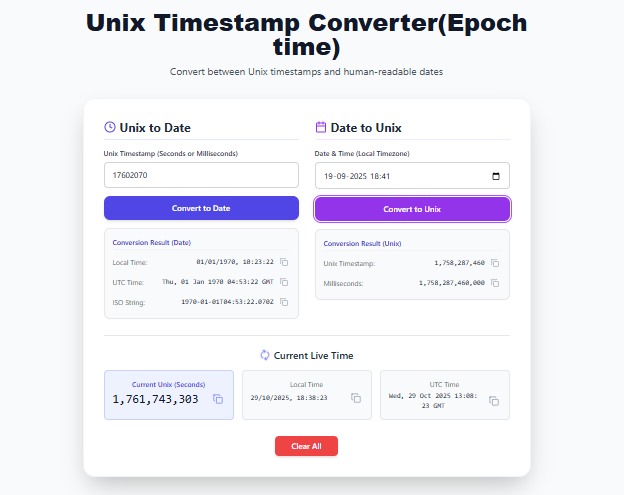🕐 Understanding UTC – The Complete Guide to Coordinated Universal Time
Time runs the modern world. From your smartphone clock to global financial systems, everything depends on precise, standardized timekeeping. The foundation of this global time coordination is UTC -- Coordinated Universal Time. Without it, international communication, travel, and technology would be chaotic.
This Solvezi UTC guide dives deep into UTC, explaining its history, difference from GMT, significance for technology and global coordination, and practical tips for converting UTC to local time using the Solvezi UTC Converter.
--
🧭 What Is UTC?
UTC (Coordinated Universal Time) is the world’s official time standard used to regulate clocks and time across all regions. It is the successor to Greenwich Mean Time (GMT) but is more precise because it is based on atomic clocks rather than Earth’s rotation.
Every local time zone in the world is defined by its UTC offset -- the difference between local time and UTC. For example:
- India (IST) → UTC +5:30
- London (UK) → UTC +0 (or +1 during summer)
- New York (USA) → UTC −5 (or −4 in daylight saving time)
UTC enables accurate world time synchronization, ensuring everyone from Tokyo to Toronto is on the same clock reference.
--
🌍 A Brief History of UTC
UTC was introduced in 1960 by the International Telecommunication Union (ITU) to replace GMT, which was based on the Earth’s rotation. Atomic clocks offered unprecedented precision, forming the basis of Coordinated Universal Time.
Since Earth’s rotation gradually slows, leap seconds are periodically added to UTC to keep it aligned with solar time. This ensures global consistency across all time-sensitive systems.
Timeline of UTC:
- 1884 – GMT adopted as the world’s reference time at Greenwich, UK.
- 1960 – UTC established, combining atomic time and astronomical observations.
- 1972 – Leap seconds introduced to maintain accuracy with Earth’s rotation.
- Present – UTC remains the international timekeeping standard, essential for world time, aviation, internet, finance, and scientific research.
--
⏱️ GMT vs UTC – Understanding the Difference
While often used interchangeably, GMT and UTC are not the same:
| Feature | UTC | GMT |
|---|---|---|
| Full Name | Coordinated Universal Time | Greenwich Mean Time |
| Basis | Atomic clock precision | Earth’s rotation |
| Leap Seconds | Uses leap seconds | Does not use leap seconds |
| Type | Scientific standard | Time zone (UK) |
| Accuracy | Extremely precise | Slightly variable |
Key Takeaway: GMT is a time zone, whereas UTC is the global time standard used for time synchronization across the world.
--
🕓 How UTC Works
UTC is maintained by a combination of atomic clocks and astronomical observations, coordinated by the International Bureau of Weights and Measures (BIPM). Over 400 atomic clocks worldwide contribute to maintaining UTC with incredible precision.
To keep UTC aligned with Earth’s rotation, leap seconds are occasionally added. For example:
2025-12-31 23:59:60 UTC
This extra second ensures world time stays in sync with the solar day, critical for navigation, aviation, and satellite communications.
--
🌐 Understanding UTC Offsets
Every time zone expresses its local time as an offset from UTC. Some offsets include minutes, not just hours, making precise conversion essential.
| Region | Time Zone | UTC Offset |
|---|---|---|
| London | GMT | UTC +0 |
| Berlin | CET | UTC +1 |
| New York | EST | UTC −5 |
| Tokyo | JST | UTC +9 |
| Sydney | AEDT | UTC +11 |
| Mumbai | IST | UTC +5:30 |
Pro Tip: Always check daylight saving time (DST) in each region, as it temporarily shifts the offset.
--
💡 Why UTC Matters
UTC is not just a technical concept; it is essential for modern life and global coordination. Here’s why:
1. Technology & Internet
All major servers, cloud services, and APIs rely on UTC timestamps. Using a single reference prevents errors across continents and devices.
2. Global Communication
Emails, video calls, and online events depend on UTC for consistent scheduling. Tools like Solvezi’s UTC Converter make planning easier.
3. Travel & Aviation
Airlines and airports worldwide use UTC to avoid confusion in flight schedules and ensure safe takeoffs and landings.
4. Finance & Trading
Stock exchanges, banks, and cryptocurrency platforms timestamp all transactions in UTC for transparency and accuracy.
5. Scientific Research
Astronomy, GPS, climate monitoring, and space exploration rely on UTC for precise timing.
SEO Tip: Including phrases like “UTC offset,” “world time,” and “time zones” throughout your content boosts visibility for searches related to time synchronization.
--
⚙️ Converting UTC to Local Time
Manual conversion requires two steps:
- Identify your UTC offset (e.g., IST = +5:30).
- Add or subtract the offset from UTC time.
- Adjust for daylight saving time if applicable.
Example:
12:00 UTC + 5:30 → 17:30 IST (India)
However, manually tracking offsets and DST changes can be error-prone. Solvezi’s UTC Converter automates this process, providing accurate results instantly.
--
🧮 Solvezi’s Free UTC Converter
The Solvezi UTC Converter offers:
- Instant UTC to local time conversion and vice versa.
- Access to 100+ time zones with auto-detection.
- Automatic handling of daylight saving time.
- A live UTC clock updating every second.
- Copy feature for easy sharing of results.
It’s a simple, reliable, and free online tool for anyone working with world time and UTC offsets.
Try it now → https://www.solvezi.com/datetime-tools/utc-converter
--
🧠 Practical UTC Conversion Examples
| City | Local Time | UTC Offset | Converted UTC |
|---|---|---|---|
| New York | 08:00 AM | UTC−5 | 13:00 UTC |
| London | 01:00 PM | UTC+0 | 13:00 UTC |
| Berlin | 02:00 PM | UTC+1 | 13:00 UTC |
| Mumbai | 06:30 PM | UTC+5:30 | 13:00 UTC |
| Tokyo | 10:00 PM | UTC+9 | 13:00 UTC |
These examples show how UTC offsets standardize time globally and why UTC converters are essential for accuracy.
--
🧩 Fun Facts About UTC
- UTC is a compromise between English (CUT) and French (TUC).
- UTC never changes for DST -- constant year-round.
- GPS satellites rely on UTC for navigation and positioning.
- Leap seconds have been added 27 times since 1972.
- Smartphones, computers, and smart devices synchronize with UTC automatically every day.
Including these facts adds value for users and improves SEO for queries like “time zones explained” and “UTC guide.”
--
✅ Key Takeaways
| Concept | Description |
|---|---|
| UTC | Coordinated Universal Time -- global standard for all clocks |
| GMT | Greenwich Mean Time -- older standard based on Earth rotation |
| Leap Seconds | Added to keep UTC in sync with solar time |
| UTC Offset | Difference in hours/minutes from UTC for a local time zone |
| Daylight Saving Time (DST) | Temporarily adjusts UTC offset in certain regions |
--
🏁 Conclusion
UTC is the backbone of modern time synchronization. From technology and finance to aviation and daily communication, Coordinated Universal Time keeps the world aligned.
Understanding UTC, GMT, and UTC offsets is essential for anyone working internationally. And for effortless conversions, the Solvezi UTC Converter is the fastest, most reliable solution.
Stay accurate. Stay global. Stay UTC-aligned. 🌐







